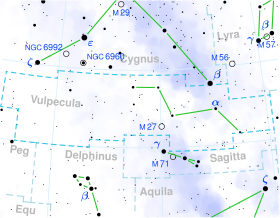Star in the constellation Vulpecula
12 Vulpeculae is a star in the northern constellation of Vulpecula , located approximately 630 light years away based on parallax. It has the variable star designation V395 Vul ; 12 Vulpeculae is the Flamsteed designation . This object is visible to the naked eye as a faint, blue-white hued star with a baseline apparent visual magnitude of 4.928. It is moving closer to the Earth with a heliocentric radial velocity of -25 km/s.
This is a variable Be star with a stellar classification of B2.5V; its brightness ranges from magnitude 4.78 down to 4.97. As is true with other Be stars, it has a high rate of rotation with a projected rotational velocity of 195 km/s. The star has 6.8 times the mass of the Sun and is radiating 963 times the Sun's luminosity from its photosphere at an effective temperature of 18,859 K.
References
^ Brown, A. G. A. ; et al. (Gaia collaboration) (2021). "Gaia Early Data Release 3: Summary of the contents and survey properties" . Astronomy & Astrophysics 649 : A1. arXiv :2012.01533 . Bibcode :2021A&A...649A...1G . doi :10.1051/0004-6361/202039657 . S2CID 227254300 .doi :10.1051/0004-6361/202039657e ). Gaia EDR3 record for this source at VizieR .
^ Harmanec, P.; et al. (2020). "A new study of the spectroscopic binary 7 Vul with a Be star primary". Astronomy and Astrophysics . 639 . Table A.1. arXiv :2005.11089 . Bibcode :2020A&A...639A..32H . doi :10.1051/0004-6361/202037964 . S2CID 218862853 .
^ Samus, N. N.; Durlevich, O. V.; et al. (2009). "VizieR Online Data Catalog: General Catalogue of Variable Stars (Samus+ 2007-2013)". VizieR On-line Data Catalog: B/GCVS. Originally Published in: 2009yCat....102025S . 1 . Bibcode :2009yCat....102025S .
^ Anderson, E.; Francis, Ch. (2012). "XHIP: An extended hipparcos compilation". Astronomy Letters . 38 (5): 331. arXiv :1108.4971 . Bibcode :2012AstL...38..331A . doi :10.1134/S1063773712050015 . S2CID 119257644 . Vizier catalog entry
^ Gontcharov, G. A. (2006). "Pulkovo Compilation of Radial Velocities for 35 495 Hipparcos stars in a common system". Astronomy Letters . 32 (11): 759–771. arXiv :1606.08053 . Bibcode :2006AstL...32..759G . doi :10.1134/S1063773706110065 . S2CID 119231169 .
^ Tetzlaff, N.; Neuhäuser, R.; Hohle, M. M. (2011). "A catalogue of young runaway Hipparcos stars within 3 kpc from the Sun" . Monthly Notices of the Royal Astronomical Society . 410 (1): 190–200. arXiv :1007.4883 . Bibcode :2011MNRAS.410..190T . doi :10.1111/j.1365-2966.2010.17434.x . S2CID 118629873 . Vizier catalog entry
^ Wu, Yue; Singh, H. P.; Prugniel, P.; Gupta, R.; Koleva, M. (2010). "Coudé-feed stellar spectral library – atmospheric parameters". Astronomy & Astrophysics . 525 : A71. arXiv :1009.1491 . Bibcode :2011A&A...525A..71W . doi :10.1051/0004-6361/201015014 . S2CID 53480665 .
^ Abt, Helmut A.; Levato, Hugo; Grosso, Monica (2002). "Rotational Velocities of B Stars" . The Astrophysical Journal . 573 (1): 359–365. Bibcode :2002ApJ...573..359A . doi :10.1086/340590 .
"12 Vul" . SIMBAD Centre de données astronomiques de Strasbourg . Retrieved 2018-11-19.
Categories :
Text is available under the Creative Commons Attribution-ShareAlike License. Additional terms may apply.
**DISCLAIMER** We are not affiliated with Wikipedia, and Cloudflare.
The information presented on this site is for general informational purposes only and does not constitute medical advice.
You should always have a personal consultation with a healthcare professional before making changes to your diet, medication, or exercise routine.
AI helps with the correspondence in our chat.
We participate in an affiliate program. If you buy something through a link, we may earn a commission 💕
↑
